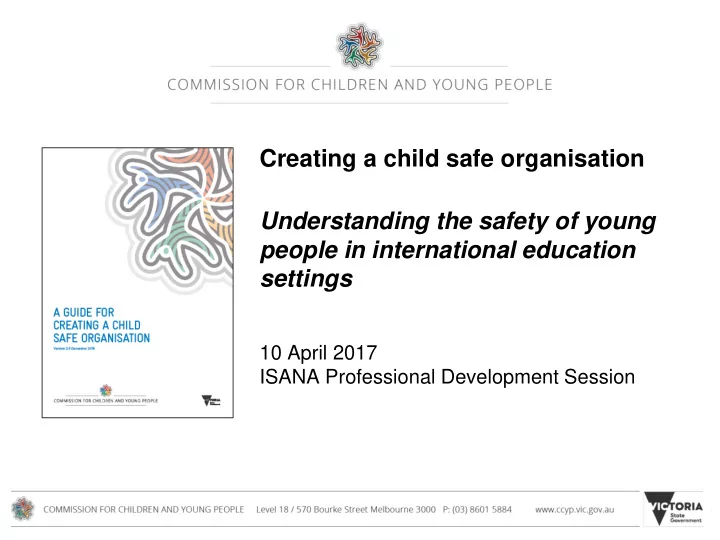

Creating a child safe organisation Understanding the safety of young people in international education settings 10 April 2017 ISANA Professional Development Session
About the Commission Liana Buchanan - Principal Commissioner of Children and Young People Andrew Jackomos - Commissioner for Aboriginal Children and Young People • Independent statutory body • Advocacy • Oversight of government services for vulnerable children and young people • Regulator of Child Safe Standards and Reportable Conduct Scheme
In this workshop we will cover… • the origins of Child Safe Standards and why we need them • what the Child Safe Standards cover • how to apply the standards in your workplace • what you can do to help promote child safety in your workplace We will use discussion based activities to share ideas and reflect on learnings
The origins of the standards and why we need them The problems • Poor practices • Unhealthy culture • Failure to respond The lifelong consequences • Relationships • Employment • Mental health • Substance abuse
From a young person’s perspective, what do you think they might see, hear and feel in a place that is safe for young people?
Overarching principles • The cultural safety of Aboriginal children and young people • The cultural safety of children and young people from culturally and/or linguistically diverse backgrounds • The safety of children and young people with a disability
What the Child Safe Standards cover 1. Strategies to embed an organisational culture of child safety , including through effective leadership arrangements 2. A child safe policy or statement of commitment to child safety 3. A code of conduct that establishes clear expectations for appropriate behaviour with children 4. Screening, supervision, training and other human resources practices that reduce the risk of child abuse by new and existing personnel 5. Processes for responding to and reporting suspected child abuse 6. Strategies to identify and reduce or remove risks of child abuse 7. Strategies to promote the participation and empowerment of children. Risk based approach that is flexible
Thinking about your work place and the services you provide, what are some of the things you do that make it safe for young people?
How to approach the standards in your workplace Drive organisational ownership and everyday thinking Talk about it with the What does a child What does abuse children, employees safe organisation look like look like and your community Assess risks of abuse occurring Develop systems and procedures to address the risks 9
Take a risk management approach to child safety • Identify the risks • Assess and evaluate the risks • Manage and treat the risks • Monitor, review and continually improve your approach.
Be proactive and pre v entative (Standard 6) • Start conversations about child safety • Have a look around • Have a look at existing policies and processes • Look at previous incidents and how these were handled • Understand social and cultural factors.
Involve children and young people in what you do (Standard 7) • Support young people to understand their rights and to raise concerns. • Actively promote and encourage young people’s participation in planning and decision making. • Value and respect young people’s opinions. • Seek young people’s views about what makes them feel safe and unsafe, including cultural safety. • Establish an environment of trust and inclusion that enables young people to ask questions and speak up if they are worried or feeling unsafe.
Define acceptable and unacceptable behaviours (Standard 3) • Provide clear written guidance on appropriate conduct and behaviour. • Detail acceptable and unacceptable behaviours relating to the specific context of your organisation. • Educate your organisational community about what’s okay and not okay. • Act on concerns or allegations of non-adherence to your Code of Conduct.
Make a firm commitment to child safety (Standard 2) • Affirm your organisation’s commitment to child safety in a child safe policy or statement of commitment to child safety. • Make your commitment to child safety easy to understand and visible. • Communicate broadly to staff, young people and your organisational community. • Require all staff to uphold this approach.
Screen, supervise and support your workforce (Standard 4) • Communicate your commitment to child safety in job advertisements. • Have clear duty statements. • Have robust pre-employment background screening, including thorough referee checks. • Provide high quality supervision and professional development.
Support people in your organisational community to take action (Standard 5) • Have a clear and easy to understand procedure for reporting concerns and allegations. • Encourage young people to report if they feel unsafe or concerned. • Make people within your organisation aware of their duty of care and legal responsibilities, and what to do to respond appropriately. • Appropriately act upon concerns and complaints. • Keep accurate records and store them securely.
Lead by example (Standard 1) • Make child safety a top priority in your organisation’s operations. • Take a zero tolerance approach to child abuse. • Lead from the top down to embed a culture that makes child safety paramount. • Apply strong governance arrangements, documenting how duty of care responsibilities to children will be met. • Respect, embrace and support the diversity of young people.
What does compliance look like? Strengthen Enforce the Child Safety Law Awareness Monitor Inform & Compliance Educate Support to Comply
Where can we get further assistance? Resources and tools available ccyp.vic.gov.au/child-safe-standards (03) 8601 5281 childsafestandards@ccyp.vic.gov.au Register on our website for updates
Online courses for outdoor education, tertiary education and supplementary education providers developed by the Australian Tutoring Association with the support of the Commission for Children and Young People Visit childsafestandards.com.au 20
Recommend
More recommend